Just about everyone maintains his or her own thinking in relation to How to Dispose of Cat Poop and Litter Without Plastic Bags.

Intro
As cat proprietors, it's essential to be mindful of how we dispose of our feline pals' waste. While it might seem practical to purge pet cat poop down the bathroom, this technique can have detrimental repercussions for both the setting and human health and wellness.
Alternatives to Flushing
The good news is, there are much safer and extra liable methods to dispose of cat poop. Take into consideration the following alternatives:
1. Scoop and Dispose in Trash
One of the most usual method of dealing with cat poop is to scoop it into a naturally degradable bag and toss it in the garbage. Be sure to use a devoted clutter inside story and throw away the waste without delay.
2. Usage Biodegradable Litter
Go with biodegradable feline litter made from materials such as corn or wheat. These litters are environmentally friendly and can be safely gotten rid of in the trash.
3. Bury in the Yard
If you have a yard, consider hiding feline waste in a designated location far from veggie yards and water resources. Make sure to dig deep sufficient to avoid contamination of groundwater.
4. Install a Pet Waste Disposal System
Buy a pet dog waste disposal system particularly made for feline waste. These systems utilize enzymes to break down the waste, decreasing odor and environmental influence.
Wellness Risks
Along with environmental problems, purging feline waste can also pose health and wellness threats to human beings. Feline feces may contain Toxoplasma gondii, a bloodsucker that can create toxoplasmosis-- a possibly serious disease, particularly for expectant ladies and individuals with weakened immune systems.
Ecological Impact
Purging cat poop presents dangerous microorganisms and parasites into the supply of water, presenting a significant risk to aquatic ecosystems. These contaminants can adversely affect marine life and compromise water quality.
Verdict
Responsible pet ownership extends past offering food and sanctuary-- it also includes correct waste administration. By avoiding flushing pet cat poop down the toilet and opting for alternative disposal techniques, we can decrease our environmental impact and safeguard human wellness.
Why Can’t I Flush Cat Poop?
It Spreads a Parasite
Cats are frequently infected with a parasite called toxoplasma gondii. The parasite causes an infection called toxoplasmosis. It is usually harmless to cats. The parasite only uses cat poop as a host for its eggs. Otherwise, the cat’s immune system usually keeps the infection at low enough levels to maintain its own health. But it does not stop the develop of eggs. These eggs are tiny and surprisingly tough. They may survive for a year before they begin to grow. But that’s the problem.
Our wastewater system is not designed to deal with toxoplasmosis eggs. Instead, most eggs will flush from your toilet into sewers and wastewater management plants. After the sewage is treated for many other harmful things in it, it is typically released into local rivers, lakes, or oceans. Here, the toxoplasmosis eggs can find new hosts, including starfish, crabs, otters, and many other wildlife. For many, this is a significant risk to their health. Toxoplasmosis can also end up infecting water sources that are important for agriculture, which means our deer, pigs, and sheep can get infected too.
Is There Risk to Humans?
There can be a risk to human life from flushing cat poop down the toilet. If you do so, the parasites from your cat’s poop can end up in shellfish, game animals, or livestock. If this meat is then served raw or undercooked, the people who eat it can get sick.
In fact, according to the CDC, 40 million people in the United States are infected with toxoplasma gondii. They get it from exposure to infected seafood, or from some kind of cat poop contamination, like drinking from a stream that is contaminated or touching anything that has come into contact with cat poop. That includes just cleaning a cat litter box.
Most people who get infected with these parasites will not develop any symptoms. However, for pregnant women or for those with compromised immune systems, the parasite can cause severe health problems.
How to Handle Cat Poop
The best way to handle cat poop is actually to clean the box more often. The eggs that the parasite sheds will not become active until one to five days after the cat poops. That means that if you clean daily, you’re much less likely to come into direct contact with infectious eggs.
That said, always dispose of cat poop in the garbage and not down the toilet. Wash your hands before and after you clean the litter box, and bring the bag of poop right outside to your garbage bins.
https://trenchlesssolutionsusa.com/why-cant-i-flush-cat-poop/

I discovered that content about Can You Flush Cat Poop Down The Toilet? when exploring the search engines. Feel free to take the opportunity to promote this blog entry if you enjoyed it. We appreciate reading our article about How to Dispose of Cat Poop and Litter Without Plastic Bags.
Book Instantly